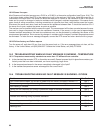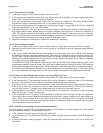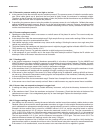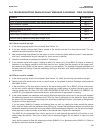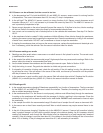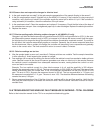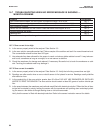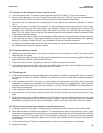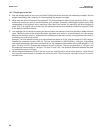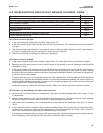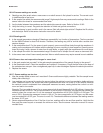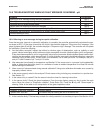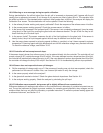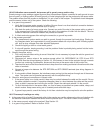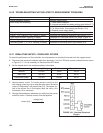
MODEL 54eA SECTION 16.0
TROUBLESHOOTING
16.7.3 Sensor can be calibrated, but the current is too low
A. Is the temperature low? The sensor current decreases about 5% for every °C drop in temperature.
B. Sensor current depends on the rate of sample flow past the sensor tip. If the flow is too low, monochloramine
readings will be low. Refer to the sensor instruction sheet for recommended sample flows.
C. Low current can be caused by lack of electrolyte flow to the cathode and membrane. See step D in Section
16.7.2.
D. When was the sensor fill solution last replaced? The monochloramine sensor loses sensitivity, that is, it gen-
erates less current per ppm of monochloramine, as it operates. Gradual loss of sensitivity can usually be com-
pensated for by calibrating the sensor weekly. After about two months, the sensitivity will have dropped to
about 70% of its original value. At this point, the electrolyte solution and membrane should be replaced. Refer
to the sensor instruction manual.
E. Is the membrane fouled or coated? A dirty membrane inhibits diffusion of monochloramine through the mem-
brane, reducing the sensor current and increasing the response time. Clean the membrane by vigorously
swirling it in a beaker of water. DO NOT use a membrane or tissue to wipe the membrane.
F. If cleaning the membrane does not improve the sensor response, replace the membrane and electrolyte solu-
tion. See the sensor instruction sheet for details.
16.7.4 Process readings are erratic
A. Readings are often erratic when a new sensor or rebuilt sensor is first placed in service. The current usually
stabilizes after a few hours.
B. Is the sample flow within the recommended range? High sample flow may cause erratic readings. Refer to the
sensor instruction sheet for recommended flow rates.
C. Verify that wiring is correct. Pay particular attention to shield and ground connections.
D. Is the membrane in good condition and is the sensor filled with electrolyte solution? Replace the fill solution
and electrolyte. Refer to the sensor instruction manual for details.
16.7.5 Readings drift
A. Is the sample temperature changing? Membrane permeability is a function of temperature. The time constant
for the sensor is about five minutes. Therefore, the reading may drift for a while after a sudden temperature
change.
B. Is the membrane clean? For the sensor to work properly, monochloramine must diffuse freely through the
membrane. A coating on the membrane will interfere with the passage of monochloramine, resulting in slow
response. Clean the membrane by vigorously swirling it in a beaker of water. DO NOT use a membrane or tis-
sue to wipe the membrane.
C. Is the sample flow within the recommended range? Gradual loss of sample flow will cause a downward drift.
D. Is the sensor new or has it been recently serviced? New or rebuilt sensors may require several hours to sta-
bilize.
E. Gradual downward drift is caused by depletion of the fill solution. Normally, calibrating the sensor every week
adequately compensates for the drift. After the sensor has been in service for several months, it will probably
be necessary to replace the fill solution and membrane. Refer to the sensor instruction manual for details.
16.7.6 Sensor does not respond to changes in monochloramine level.
A. Is the grab sample test accurate? Is the grab sample representative of the sample flowing to the sensor?
B. When was the sensor fill solution last replaced? The monochloramine sensor loses sensitivity, that is, it gen-
erates less current per ppm of monochloramine, as it operates. After about two months, the sensitivity will have
dropped to about 70% of its original value. If the fill solution is extremely old, the sensor may be completely
non-responsive to monochloramine. Replace the fill solution and membrane. See the sensor instruction man-
ual for details.
C. Is the membrane clean? Clean the membrane with a stream of water and replace it if necessary.
D. Replace the sensor.
95




